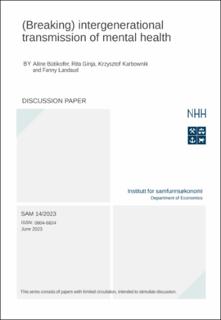| dc.contributor.author | Bütikofer, Aline | |
| dc.contributor.author | Ginja, Rita | |
| dc.contributor.author | Karbownik, Krzysztof | |
| dc.contributor.author | Landaud, Fanny | |
| dc.date.accessioned | 2023-07-03T06:12:14Z | |
| dc.date.available | 2023-07-03T06:12:14Z | |
| dc.date.issued | 2023-06-30 | |
| dc.identifier.issn | 0804-6824 | |
| dc.identifier.uri | https://hdl.handle.net/11250/3075265 | |
| dc.description.abstract | We estimate health associations across generations and dynasties using information on healthcare visits from administrative data for the entire Norwegian population. A parental mental health diagnosis is associated with a 9.3 percentage point (40%) higher probability of a mental health diagnosis of their adolescent child. Intensive margin physical and mental health associations are similar, and dynastic estimates account for about 40% of the intergenerational persistence. We also show that a policy targeting additional health resources for the young children of adults diagnosed with mental health conditions reduced the parent-child mental health association by about 40%. | en_US |
| dc.language.iso | eng | en_US |
| dc.relation.ispartofseries | SAM DP;14/2023 | |
| dc.subject | Mental Health, Intergenerational Persistence, Dynastic Effects, Public Policy | en_US |
| dc.title | (Breaking) intergenerational transmission of mental health | en_US |
| dc.type | Working paper | en_US |
| dc.source.pagenumber | 76 | en_US |
| dc.relation.project | Norges Forskningsråd: 262675, NORFACE DIAL grant: 462-16-050 | en_US |
